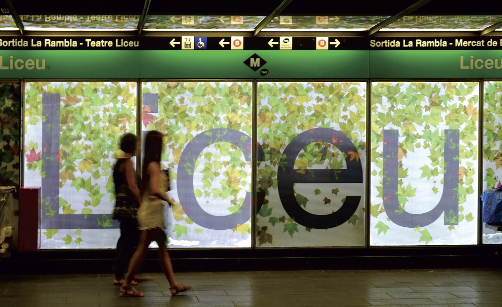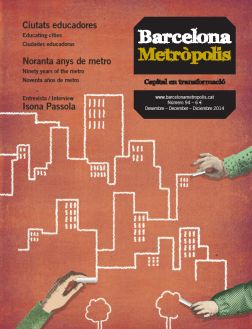At some stage we should look closely at the signs of stations and ask ourselves what those words mean, because they are full of historic, geographical, and personal references.

© Vicente Zambrano
Image of Liceu station, currently on line 3, which was the terminus for line I from 1925, the year after its inauguration, to 1946, when the Fernando-Ramblas station was added.
Mankind was born on planet Earth. And when I say planet Earth, I mean its surface. That place where species could live and evolve.
After a few millennia, however, they tried to conquer the air, and were successful. They first tried using balloons and later planes. They discovered it was possible to move around in another medium.
There was still another area where they hadn’t yet discovered how to move around freely – the one beneath their ancestral surface.
And so the metro was born.
It could be said to be the conquest of a third dimension: the underground.
The metro, which started out as a single tunnel, has progressively branched out and become a network, like an increasingly dense woven tapestry.
This has enabled the emergence of a revolutionary new perception incorporating two fundamental values of life: time and distance. Consider ancient times, when man only moved about on foot. He shared this limitation with most land animals until the advent of the horse and carriage.
And that was until the metro added a major innovation: speed. In big cities, faster transport times were achieved precisely because the obstacles found on the surface did not exist for the metro. It was thus able to achieve fast, sustained speeds.
Today, Barcelona without its metro would be unfathomable; the city would be like a body with major nerves removed.
For me, another quality of the metro is that it speaks to us, at least to those of us with the curiosity to read signs. Of course, passengers in a hurry only need to see the map indicating where to get off. We generally do not notice what all of the signs say, apart from those that let us know where we are on our journey.
Perhaps it would a good idea to occasionally take notice of one of those signs and ask ourselves about the meaning behind each word, because all metro lines contain a parade of historical, geographical and personal references. La Verneda (“Alder Grove”) tells us that there used to be a forest with alder trees in that neighbourhood. Likewise, the name Llacuna (“Lagoon”) tells us that the district experienced, in earlier times, an invasion of sea water. Mediaeval ships were built near the Drassanes (“Shipyard”) station to service Catalonia’s Mediterranean expansion. And Penitents (“Penitents”) used to be a neighbourhood for hermitages, however hard that is to believe now.
The cars of the Barcelona metro, endlessly coming and going, weave a tapestry revealing diverse aspects of past and present life.
When getting off at a station I take a look at the sign and, if I grasp the meaning behind it, offer my thanks.



